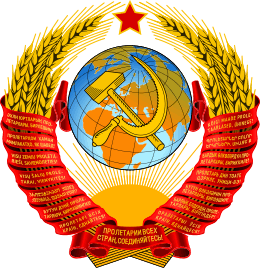Hero of the Soviet Union
The title Hero of the Soviet Union (Russian: Герой Советского Союза, romanized: Geroy Sovietskogo Soyuza) was the highest distinction in the Soviet Union, awarded personally or collectively for heroic feats in service to the Soviet state and society.[1]
| Hero of the Soviet Union | |
|---|---|
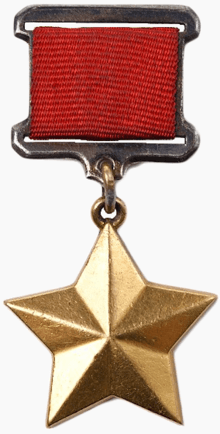 Gold star medal of the Hero of the Soviet Union | |
| Awarded by the | |
| Type | Honorary title |
| Eligibility | Soviet and foreign citizens |
| Awarded for | Heroic feats in service to the Soviet state and society |
| Status | No longer awarded |
| Statistics | |
| Established | 16 April 1934 |
| First awarded | 20 April 1934 |
| Last awarded | 24 December 1991 |
| Total awarded | 12,777 |
| Precedence | |
| Next (lower) | Order of Lenin |
| Related | Hero of the Russian Federation |
Overview
The award was established on April 16, 1934, by the Central Executive Committee of the Soviet Union.[2] The first recipients of the title originally received only the Order of Lenin, the highest Soviet award, along with a certificate (грамота, gramota) describing the heroic deed from the Presidium of the Supreme Soviet of the USSR. Because the Order of Lenin could be awarded for deeds not qualifying for the title of hero, and to distinguish heroes from other Order of Lenin holders, the Gold Star medal was introduced on August 1, 1939.[3] Earlier heroes were retroactively eligible for these items.
A hero could be awarded the title again for a subsequent heroic feat with an additional Gold Star medal and certificate. An additional Order of Lenin was not given until 1973. The practice of awarding the title multiple times was abolished by the Supreme Soviet of the USSR in 1988 during perestroika.
Forty-four foreign citizens were awarded the title.[4]
The title was also given posthumously, though often without the actual Gold Star medal given.
The title could be revoked only by the Presidium of the Supreme Soviet.[5]
Privileges
Individuals who received the award were entitled to special privileges, including:
- A pension with survivor benefits in the event of the death of the title holder.
- First priority on the housing list with 50% rent reduction, tax exempt and an additional 45 square metres (480 sq ft) in living space.
- Annual round-trip first class airline ticket
- Free bus transportation
- Free annual visit to sanatorium or rest home
- Medical benefits
- Entertainment benefits
History
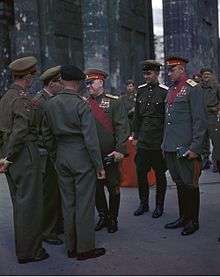
In total, during the existence of the USSR, the title of Hero of the Soviet Union was awarded to 12,777 people (excluding 72 stripped of the title for defamatory acts and 13 awards annulled as unwarranted), including twice – 154 (9 posthumously), three times – 3 and four – 2. Ninety-five women were awarded the title. Among the Heroes of the Soviet Union, 44 people are citizens of foreign states. The great majority of them received it during World War II (11,635 Heroes of the Soviet Union, 101 twice Heroes, three thrice Heroes, and two four-time Heroes). Eighty-five people (28 posthumously) were awarded the title for actions related to the Soviet-Afghan War, which lasted from 1979 until 1989.[6]
The first recipients of the award were the pilots Anatoly Liapidevsky (certificate number one), Sigizmund Levanevsky, Vasily Molokov, Mavriky Slepnyov, Nikolai Kamanin, Ivan Doronin, and Mikhail Vodopianov, who participated in the successful aerial search and rescue of the crew of the steamship Cheliuskin, which sank in Arctic waters, crushed by ice fields, on February 13, 1934. Valentina Grizodubova, a female pilot, was the first woman to become a Hero of the Soviet Union (November 2, 1938)[7] for her international women's record for a straight-line distance flight. Zoya Kosmodemyanskaya, a Soviet partisan, was the first woman to become a Hero of the Soviet Union during World War II (February 16, 1942), posthumously.
In addition, 101 people received the award twice. A second Hero title, either Hero of the Soviet Union or Hero of Socialist Labour entitled the recipient to have a bronze bust of his or her likeness with a commemorative inscription erected in his or her hometown.[8]
Two famous Soviet fighter pilots, Aleksandr Pokryshkin and Ivan Kozhedub were three times Heroes of the Soviet Union. A third award entitled the recipient to have his/her bronze bust erected on a columnar pedestal in Moscow, near the Palace of the Soviets, but the Palace was never built.
After his release from serving a 20-year sentence in a Mexican prison for the assassination of Leon Trotsky, Ramón Mercader moved to the Soviet Union in 1961 and was awarded the Hero of the Soviet Union medal from KGB head Alexander Shelepin.
The only individuals to receive the title four times were Marshal Georgy Zhukov and Leonid Brezhnev. The original statute of the Hero of the Soviet Union, however, did not provide for a fourth title; its provisions allowed for a maximum of three awards regardless of later deeds. Both Zhukov and Brezhnev received their fourth titles under controversial circumstances contrary to the statute, which remained largely unchanged until the award was abolished in 1991. Zhukov was awarded a fourth time "for his large accomplishments" on the occasion of his 60th birthday on December 1, 1956. There is some speculation that Zhukov's fourth Hero medal was for his participation in the arrest of Beria in 1953, but this was not entered in the records. Brezhnev's four awards further eroded the prestige of the award because they were all birthday gifts, on the occasions of his 60th, 70th, 72nd and 75th birthdays. Such practices halted in 1988 due to a decision of the Supreme Soviet of the USSR, which formally ended it.
By the 1970s, the award had been somewhat devalued. Important political and military persons had been awarded it on the occasions of their anniversaries rather than for any immediate heroic activity.
All Soviet cosmonauts, starting from Yuri Gagarin, as well as foreign citizens who participated in the Soviet space program as cosmonauts, received Hero award for each flight (but no more than twice).
Apart from individuals, the title was also awarded to twelve cities (Hero City) as well as the fortress of Brest (Hero-Fortress) for collective heroism during the War.
The last recipient of the title "Hero of the Soviet Union" was a Soviet diver, Captain of the 3rd rank Leonid Mikhailovich Solodkov on December 24, 1991 for his leadership and participation in a series of unprecedented extreme depth diving experiments.[9] Following the collapse of the Soviet Union, this title was succeeded in Russia by the title "Hero of the Russian Federation", in Ukraine by "Hero of Ukraine" and in Belarus by "Hero of Belarus". Azerbaijan's successor order is that of National Hero of Azerbaijan and Armenia's own hero medal is that of National Hero of Armenia, both modeled on the Soviet one.
Heraldry
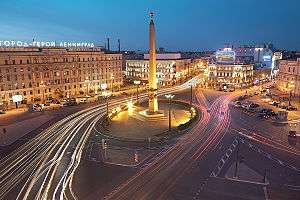 Hero of Soviet Union obelisk of Saint Petersburg.
Hero of Soviet Union obelisk of Saint Petersburg.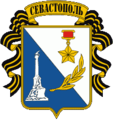 Coat of arms of the Hero-City of Sevastopol
Coat of arms of the Hero-City of Sevastopol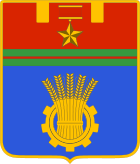
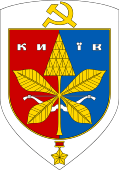
 Flag of the Hero-City of Tula
Flag of the Hero-City of Tula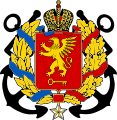

Philately
.jpg)
.jpg)
.jpg) Hero of the Soviet Union Lieutenant Alexander Kosmodem'yanskii
Hero of the Soviet Union Lieutenant Alexander Kosmodem'yanskii.jpg) Twice Hero of the Soviet Union Sergey Ivanovich Gritsevets
Twice Hero of the Soviet Union Sergey Ivanovich Gritsevets Hero of the Soviet Union Alexander Matrosov
Hero of the Soviet Union Alexander Matrosov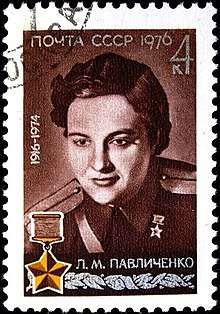 Hero of the Soviet Union Lyudmila Pavlichenko
Hero of the Soviet Union Lyudmila Pavlichenko
Notable recipients
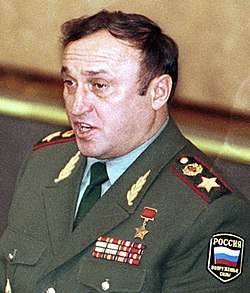
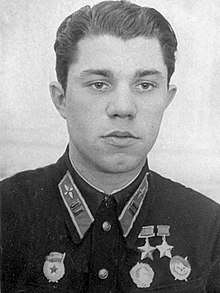
Single award
- Oleg Babak - last posthumous recipient to die in the line of duty.
- Mikhail Devyataev – escaped from a forced-labor camp at Peenemünde with crucial intelligence on German rocket programs.
- Andrei Durnovtsev – pilot who dropped the Tsar Bomba
- Yuri Gagarin – first human to fly in space.
- Pavel Grachev – division commander in Afghanistan.
- Ivan Kharchenko – neutralized more than 50,000 explosive items during and after World War II.
- Nikolai Kuznetsov – intelligence officer responsible for the kidnappings and assassinations of several high-ranking Nazis.
- Valentin Kotyk – Youngest recipient (age 14). Posthumously awarded after being killed in combat during the Great Patriotic War
- Vladimir Konovalov – submarine commander; sank the German ship Goya.
- Zoya Kosmodemyanskaya – the first woman awarded the title during World War II.
- Alexander Krivets – participant in the Soviet partisan movement during World War II, commander of the Shchors partisan detachment.
- Matvey Kuzmin – oldest recipient; led a Nazi division to an ambush in Malkino.
- Lydia Litvyak – World War II fighter pilot and the world's top female ace.
- Alexander Marinesko – the most successful Soviet submarine commander in terms of gross register tonnage (GRT) sunk.
- Alexander Matrosov – posthumously awarded for blocking an enemy machine-gun with his own body.
- Nikolai Melnik – Soviet pilot known for placing radiation sensors at the Chernobyl's Nuclear Power Plant, Reactor 4, during the 1986 explosion.
- Aliya Moldagulova – sniper who led her brigade after suffering high casualties
- Pore Mosulishvili – Soviet Soldier and member of the Italian resistance.
- Ivan Panfilov – Soviet general. Killed in action during the Battle of Moscow. The 8th Guards Rifle Division of the Red Army was named in his honor.
- Lyudmila Pavlichenko – highest scoring female sniper.
- Yakov Pavlov – commanded the defenders of the building named after him in Stalingrad.
- Nikolay Pukhov – Colonel General in World War II and the first commander of the 8th Tank Army.
- Endel Puusepp – Soviet World War II bomber pilot.
- Vladimir Pravik – firefighter who died in the Chernobyl disaster.
- Otto Schmidt – scientist and explorer of the Arctic.
- Ivan Sidorenko – One of the top snipers of World War II, with over 500 kills.
- Richard Sorge – Soviet spy, reported from Japanese information the exact date that Operation Barbarossa would begin.
- Joseph Stalin – General Secretary of the Communist Party (1922–1953) and Head of Government as Prime Minister of the USSR (1941–1953).
- Leonid Telyatnikov – Head of the fire department at the Chernobyl Nuclear Power Plant
- Valentina Tereshkova – first woman to fly in space.
- Michael Tsiselsky – Soviet naval pilot during World War II.
- Zhambyl Tulaev – soviet sniper, killed 313 German soldiers.
- Dmitriy Ustinov – Marshal of the Soviet Union and Minister of Defense of the Soviet Union from 1976 until his death in 1984.
- Vasily Zaytsev – sniper who killed 225 at the Battle of Stalingrad; his achievements are dramatized in the film Enemy at the Gates.
- Viktor Zholudev – posthumously awarded for leadership during Operation Bagration
Two times awarded
- Konstantin Rokossovsky – Marshal of the Soviet Union and Commander of the 1st and 2nd Belorussian Front during World War II.
- Hazi Aslanov – Major General of armored troops during World War II.
- Talgat Bigeldinov – Il-2 during World War II and the only Kazakh who was twice awarded the title.
- Vasily Chuikov – General largely responsible for the victory at Stalingrad and attacking Berlin.
- Oleksiy Fedorov – organized underground resistance in Nazi-occupied Ukraine.
- Dmitry Glinka – flying ace with over 50 shootdowns
- Aleksei Leonov – cosmonaut who made the world's first spacewalk in 1965.
- Vasily Petrov – Major who lost both hands during the second World War.
- Pyotr Ilyich Klimuk – Cosmonaut, former head of the Yuri Gagarin Cosmonaut Training Center.
- Vladimir Kokkinaki – Famous test pilot and record breaker.
- Vladimir Komarov – Cosmonaut, second award posthumous after his death onboard Soyuz 1.
- Sydir Kovpak – partisan leader in Ukraine.
- Boris Safonov – World War II naval pilot and flying ace
- Nelson Stepanyan – World War II ground-attack pilot.
- Vladimir Solovyov – Cosmonaut, former director of Mir and last man on Salyut 7.
- Amet-khan Sultan – World War II fighter ace and test pilot.
- Semyon Timoshenko – military commander and senior professional officer of the Red Army, Marshal of the Soviet Union and People's Commissar of State for National Defense.
Three times awarded
- Semyon Budyonny – Military Commander, 1st Cavalry Army in the Civil War and later of the Army Cavalry Commands, also Marshal of the Soviet Union and from 1937 to 1940, Commanding Officer, Moscow Military District.
- Ivan Kozhedub – highest-scoring Soviet fighter pilot
- Alexander Pokryshkin – World War II fighter pilot
Four times awarded
- Leonid Brezhnev — First Secretary, later General Secretary, of the CPSU (1964–82), and Chairman of the Presidium of the Supreme Soviet of the USSR (1964–82), also awarded one Hero of Socialist Labour; this last feat was the subject of numerous Russian jokes. Also Marshal of the Soviet Union.
- Georgy Zhukov — Military commander and politician credited with many of the most significant Soviet victories of World War II, Commander of the First Belorussian Front and Marshal of the Soviet Union.
Foreign recipients (all single awards)
.svg.png)


.svg.png)
.svg.png)
.svg.png)
.svg.png)


















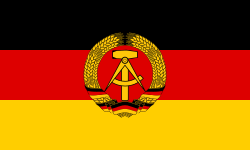



.svg.png)




.svg.png)





.svg.png)
.svg.png)


See also
- Awards of the Soviet Union
- Hero of Socialist Labor
- Hero of the Russian Federation
- Hero of Belarus
- Hero of Ukraine
- Hero of the Republic of Cuba
- Hero of the People's Armed Forces
- Order of Lenin
- Medal of Honor, Presidential Medal of Freedom, Congressional Space Medal of Honor
Notes
- Prokhorov, Aleksandr Mikhaĭlovich (1982). Great Soviet Encyclopedia, Volume 6. New York: Macmillan. p. 594. OCLC 810278.
- "Resolution of the Central Executive Committee of the Soviet Union of May 5, 1934" (in Russian). Wikisource. 2010-09-04. Retrieved 2012-02-20.
- "Decree of the Presidium of the Supreme Soviet of the USSR of August 1, 1939" (in Russian). Wikisource. 2011-09-28. Retrieved 2012-02-20.
- Статистика :: Герои страны [Statistics]. www.warheroes.ru (in Russian). Retrieved 2016-01-25.
- McDaniel and Schmitt, The Comprehensive Guide to Soviet Orders and Medals.
- "Archived copy". Archived from the original on 2008-02-13. Retrieved 2005-10-07.CS1 maint: archived copy as title (link)
- (in Russian) Гризодубова Валентина Степановна
- https://ru.wikisource.org/wiki/%D0%9F%D0%BE%D1%81%D1%82%D0%B0%D0%BD%D0%BE%D0%B2%D0%BB%D0%B5%D0%BD%D0%B8%D0%B5_%D0%A6%D0%98%D0%9A_%D0%A1%D0%A1%D0%A1%D0%A0_%D0%BE%D1%82_16.05.1934_%D0%93%D0%B5%D1%80%D0%BE%D0%B9_%D0%A1%D0%A1%D0%A1%D0%A0
- "As Leonid Solodkov was the last hero of the Soviet Union?". Retrieved 5 September 2015.
- "Герой Советского Союза Горанов Волкан Семёнович :: Герои страны". Retrieved 5 September 2015.
- "Шменкель (Shmenkel) Фриц Пауль". www.warheroes.ru. Retrieved 2016-01-25.
- "Джибелли Примо Анжелович". www.warheroes.ru. Retrieved 2016-01-25.
External links
| Wikimedia Commons has media related to Hero of the Soviet Union. |
- Website dedicated to Heroes of the Soviet Union and Russia (in Russian)
- Hero of the Soviet Union - an article on the title (in Russian)
- Alley of Heroes of the Soviet Union in Volgograd - history and photos (in Russian)
- Legal Library of the USSR (in Russian)
